Transforming Outdoor Spaces: Placemaking
Specifying Coiled Wire Fabric
When selecting a coiled wire fabric system for an outdoor space, there are a many different choices of how it can be specified. Here are some things to keep in mind when specifying and designing with this innovative material.
Material makeup. Coiled wire fabric systems begin with a base metal wire in varieties of steel, aluminum, brass, copper, or stainless steel. The choice of the wire material and its gauge impact the weight, functionality, and aesthetics of the final fabric. By altering the base material, wire gauges, weave pattern, and finishes, the strength, rigidity, and appearance can all be chosen to meet the design or performance characteristics being sought. It is worth noting that the fabric is available in virtually unlimited widths, and up to 40 feet in length or height, so large installations can be achieved with a single panel in many cases. For projects needing more than a 40-foot span of fabric, multiple coils can be spliced together at the job site in a routine fashion and still create a continuous appearance.
Light Transparency. Coiled wire fabric will allow light to pass through, but how much and how visually transparent it appears will be based directly on the specified make-up of a particular fabric. Those with thicker wires and tighter weaves will obviously allow less light than those with thinner wires and more open weaves. Architects and designers can vary the level of transparency or sun shading by altering these factors to suit their needs. “Fullness” is another factor that designers can alter which will vary the level of light able to pass through the coiled wire fabric. By using more material than what is required to cover a given area, a billowing drapery effect may be achieved, causing the mesh to overlap which can be used to allow the desired amount of light penetration.
Formability. As with any fabric type of product, coiled wire fabric is free flowing and flexible. That means it can be formed and shaped to create undulating or curved surfaces, flat taut surfaces, or a combination of any of these. That allows for a high degree of creativity in how spaces are defined and articulated, both for walls and ceilings.Color. Coiled wire fabric is available in either a natural, uncoated state, or with resilient powder-coating finishes for a sharp, long-lasting aesthetic. The color choices are broad, allowing it to be a successful part of virtually any design scheme. Further, the finishes can be specified to match any RAL color code or specified to comply with Declare labels from the International Living Future Institute to protect human health when used on interiors.
Performance Traits. It can be used for light diffusion or shading to enhance or control the ambient lighting of a space. It also serves very nicely as a surface to receive nighttime lighting. In appropriate strengths, it can provide partitioning for safety, fall protection, blast mitigation, and security. Further, when used in outdoor spaces, the material is durable enough to withstand those rigors as well.
Cost Effectiveness. Compared to the full construction of rigid partitions or other separation elements, coiled wire fabric is a very affordable option. It is also more economical than commercial woven wire mesh that is typically designed for other purposes. This affordability lets architects and designers flex their creativity, produce signature designs, and turn projects with modest budgets into something unique, innovative, and responsive to project needs.
Designers who recognize the innovative uses of this product and its sustainability traits can achieve successful outcomes when used in outdoor settings.
Redwood Lumber And Timbers
One very legitimate concern about creating outdoor spaces is the choice of materials to be used. Anything specified needs to be able to handle the constant exposure to sun, wind, rain, and other weather conditions. It also needs to be strong and durable enough to handle the activity and operations of the people who use the space. In addition, the aesthetics must be right, and the sustainability of the material needs to be accounted for.

Photos courtesy of Humboldt Sawmill Company
Natural redwood lumber and timbers have long been prized for their warm appearance coupled with their natural traits of durability and longevity.
Considering all of these criteria, redwood lumber and timbers are seen as an excellent option for landscape architecture and design. Natural redwood is regarded as one of nature’s finest and strongest building materials. Structurally, redwood has a shear strength up to five times greater than plastic and composite decking. From a durability standpoint, redwood, in particular the heartwood from the center of the tree, is known to be naturally resistant to decay and termites. This was first discovered in redwood forests in California where fallen trees were found to have been laying on the ground for decades with no visible sign of any significant decay,─very unlike other trees that can decay naturally quite quickly.
Regarding the appearance, many designers agree that no other decking material mimics the natural beauty and warmth found in real redwood deck boards and accessories. It’s rich, warm color and grain pattern look great when installed and maintains its appeal even with age. Redwood can be left untreated due to its natural resistance properties and allowed to patina over time, or it can be stained or finished to preserve a particular color and look. Either way, it is a lightweight wood that is easy to work with, which helps control overall construction costs.
When redwood is used for decking, it naturally achieves a Class B flame spread. That means it is approved for use in California’s Wildland Urban Interface (WUI) fire hazard severity zones without restriction. For situations where a higher degree of fire resistance is needed, it can be treated to achieve a Class A flame spread using proven and tested processes that are registered with state agencies and building codes. The design flexibility and performance characteristics of redwood decking means it can be used in either renovation projects or new construction. Redwood decking also works well with innovative, newer deck components such as glass panel railing systems or cable railings. The warmth of the wood complements a variety of the other materials, like glass and metal.
Aesthetic Safety Railings
Anytime an outdoor space is used by people, it brings some safety considerations. For example, the International Building Code requires guardrails to protect people from falls anytime a deck or platform is raised up more than 30 inches above the ground. Similarly, if an outdoor space is adjacent to vehicular traffic, it is considered a best safety practice to use some method to prevent people from accidentally walking into harm’s way. The design issue often becomes how to provide the needed safety while incorporating an aesthetic solution or one that does not detract from natural features, such as views or vegetation.
One popular solution to this need for a functional yet aesthetic railing is the use of cable rail systems. Commonly, such systems use horizontal, stainless-steel cables spaced no more than 4 inches apart (to meet code requirements) and held in place with primary and intermediate uprights. A solid top rail is also common made from wood or aluminum. Such manufactured products are durable and have long use cycles, thereby reducing replacement costs and maximizing material usage efficiency. They are typically very low maintenance and require no treatments, stains, solvents, varnishes, or preservatives that may contain contaminating chemicals. The materials and products tend to be strong yet lightweight, using less raw material and allowing easier handling, lower shipping costs and lower fuel consumption. They are also available with high recycled content, making them inherently sustainable.
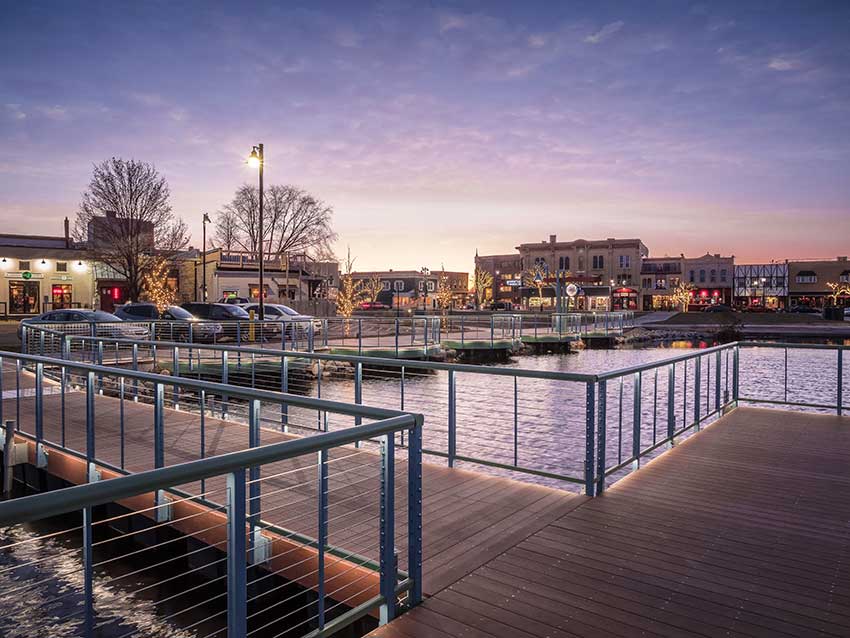
Photo courtesy of Feeney, Inc.
Cable rail systems combine posts and rails with stainless steel cables that minimize the obstruction of views and are made from sustainable materials.
Cable Rail Systems
The successful design of a cable railing is about more than just the stainless steel cables. Like most construction products, there are several components that need to be coordinated. From a design standpoint, that also means there are numerous options for custom or standardized installations. The fundamental design considerations include the following:
Post Material: The vertical posts provide the stability and connection to the deck or platform structure. There are three common choices of post material. The first is wood, or whatever variety may be desired, that can be stained or left natural as the species may allow. Second is metal, which is most commonly aluminum with an anodized or powder coated finish. Other metals are possible as well. Third is a composite material that may or may not match a composite decking material for a particular application. The distinctions between these three post types go beyond the visual and the structural, since each will have implications for the way that cables are attached or pass through them.
Corner Design: The corner of a deck or platform can be treated with either a single corner post or a double post. In the case of a single post, the cables typically terminate at the corner such that one set of cables attaches on one face of the post and the other set on an adjacent face (i.e., 90 degrees from each other). In order to properly address the connection and the imposed tension, the cables in this design are offset slightly from each other (on the order of a half inch). If that offset is not desired, two posts can be used in the corner such that each post is secured to a different face of the deck (still 90 degrees from each other). This will allow all of the cables to be in line with each other. In fact, the cables could be continuous around the corner, or they could each terminate on a different post as desired.
Top and Bottom Rails: A strong and rigid top rail that is securely fastened to the posts provides the necessary strength to the overall system and helps to support the tension loads from the cable. Underneath the top rail, it is often recommended that 1-by-4-inch wood blocking is installed between posts to provide additional lateral reinforcement to the posts. The material for the top rail can be the same as the posts or different at the discretion of the designer. Along the same idea, a bottom rail can be installed as an optional means to provide additional rigidity to the railing. It can also be an attractive and functional footrest addition to the overall railing design.Intermediate Pickets: As a means of keeping the cable properly aligned, an intermediate vertical picket can be placed between each set of posts. Slender aluminum or stainless steel pickets are available as part of an overall system to achieve a visually open design while maintaining proper cable alignment.
Cables: The usual means of purchasing the stainless steel cable needed for the railing, is in a spool. The cable is unwound and cut to length for the multiple parallel rows (9 – 15) needed for a particular railing. For most residential and light commercial installations, 1/8-inch diameter cable is sufficient. For a bolder look and extra strength, 3/16-inch cable can be specified. In high traffic areas or for special architectural railings, ¼ inch cable may be required. In all cases the common cable construction types include 1x19 or 7x7 configurations. In the 1x19 construction, 19 individual wires are twisted into a single semi-flexible strand. This is an excellent choice for most railings, fences, and trellises with straight runs or slight bends. The 7x7 cable uses 7 groups of 7 wires (for a total of 49 individual wires) that are woven into a flexible strand. This type is best suited to conditions that require tighter bends or for designs where a more woven wire appearance is desired.
Connection Hardware: Consultation with a manufacturer is recommended to understand the range of current available choices for the hardware used to connect the cable railing to the posts. Some are specifically designed for the type of post material used. Others are designed for more visual concealment than others. Some are appropriate for stair railings. In all cases, the proper hardware is needed in order to assure that the installation is done properly and will not suffer from connection failures.
LED Rail lighting: An available option on some systems is the opportunity to have an upper and/or lower rail that incorporates linear LED lighting within it. This places the light where it is often most needed, at the edges or perimeters of a space, while also providing ambient light to the outdoor space. Electrical connections need to be factored in, of course, but can terminate at convenient locations to optimize construction efficiency.
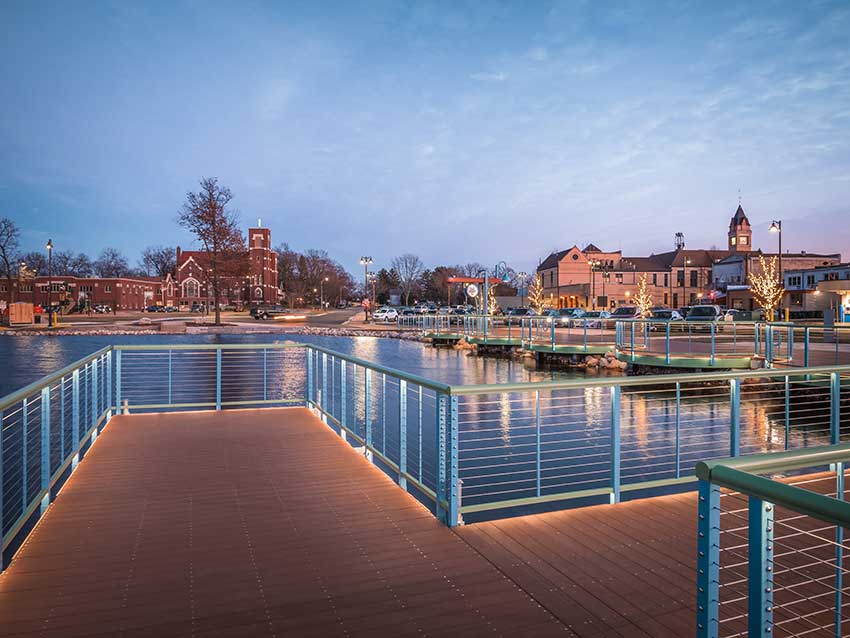
Photo courtesy of Feeney, Inc.
The use of LED lights in a cable rail system provide a welcoming way and energy efficient way to illuminate outdoor spaces.
Notice
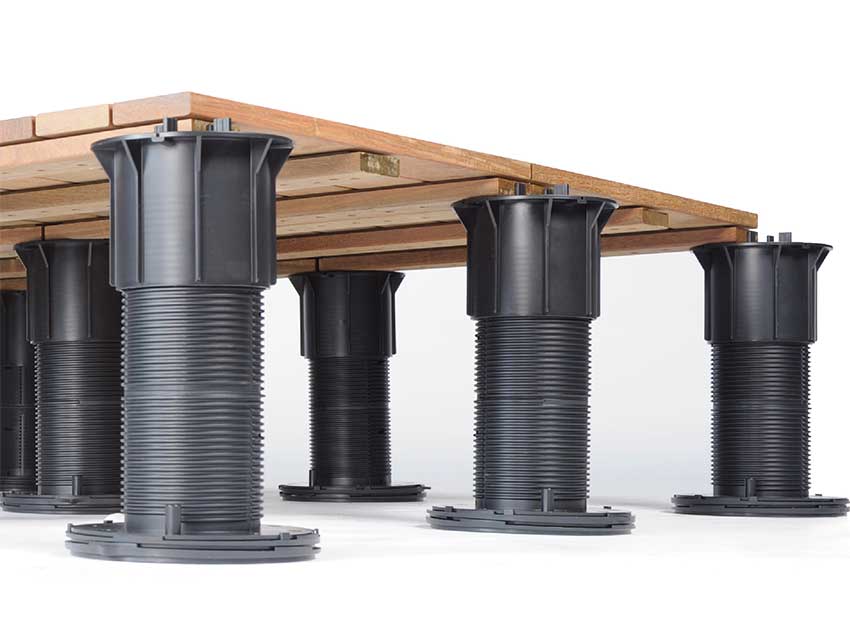
www.bisonip.com
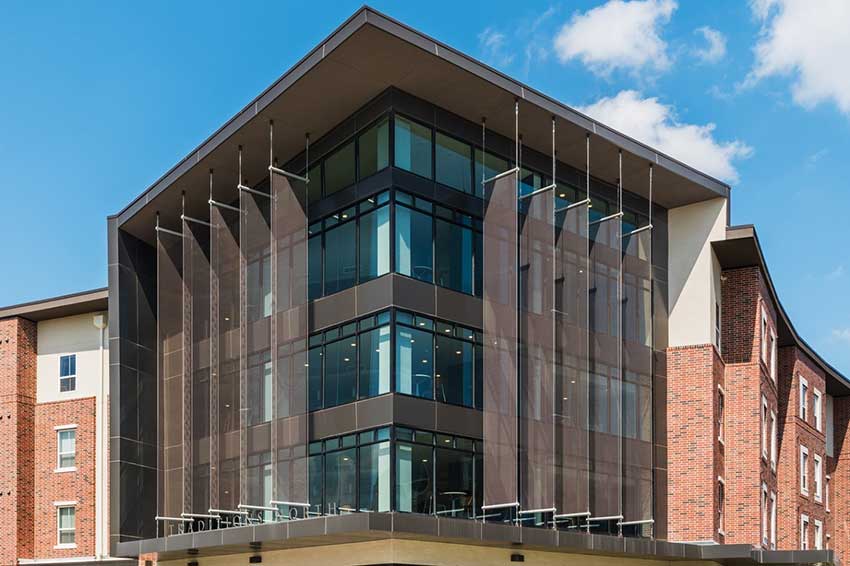
www.cascade-architectural.com
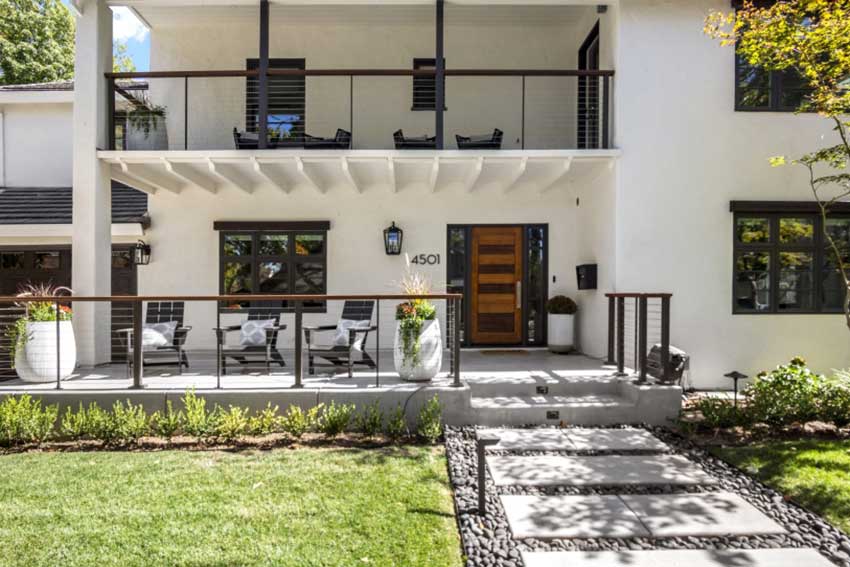
www.feeneyinc.com
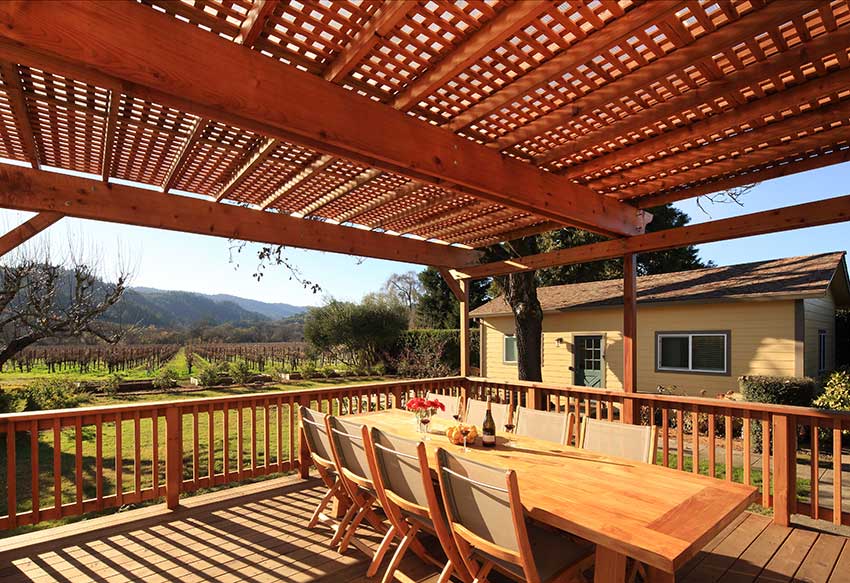
www.getredwood.com
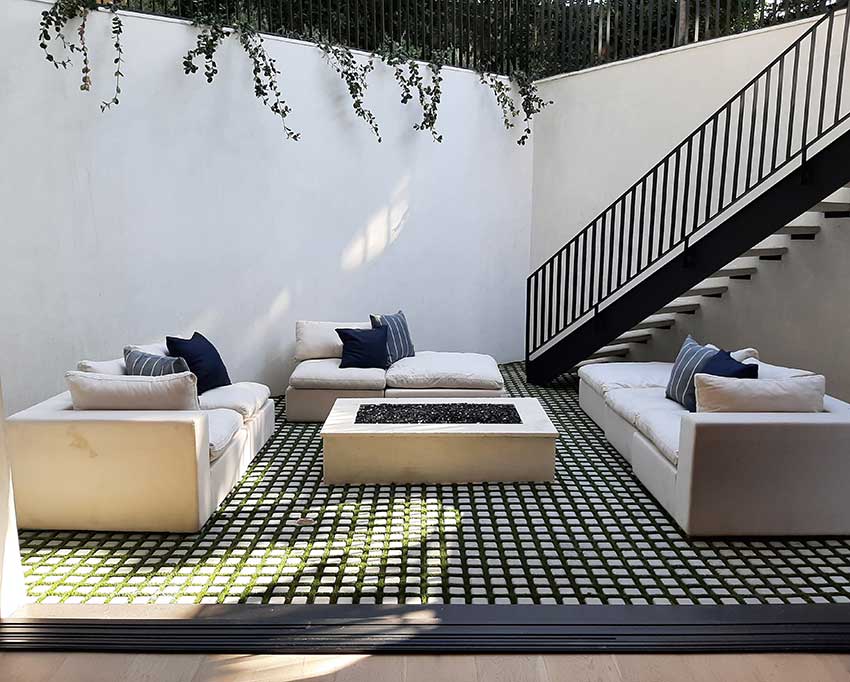
www.soilretention.com









